
Golf clubs are designed with specific standard dimensions to optimize performance and ensure fairness in the game. For example, according to the Rules of Golf, the maximum length for most golf clubs is 48 inches, except for putters, which may vary. The clubhead must not exceed 5 inches from heel to toe and 2.5 inches from face to back, ensuring consistency across different club types. These standards help golfers choose clubs that suit their playing style while staying within the regulations set by official golf organizations.
Loft Angle
The loft angle of a golf club plays a crucial role in determining the trajectory and distance of your shots. Typically measured in degrees, loft angles for drivers range from 8 to 13 degrees, with higher lofts providing a higher ball trajectory, beneficial for beginners. In contrast, iron clubs generally have loft angles between 20 and 60 degrees, allowing for precision and control in various approach shots. Understanding and selecting the correct loft angle tailored to your swing can significantly enhance your performance on the course.
Length Of Shaft
The standard length of a golf club shaft typically ranges from 33 to 46 inches, depending on the type of club and the player's height and swing style. A standard driver shaft length is usually around 45 inches, designed to maximize distance while maintaining accuracy. For putters, the shaft length generally falls between 32 and 36 inches, tailored to provide a comfortable stance and alignment. Ensuring the right shaft length can significantly impact your performance, influencing both the trajectory of your shots and your overall game consistency.
Lie Angle
Lie angle, a critical specification in golf clubs, refers to the angle between the shaft and the ground when the club is resting flat. A standard lie angle typically ranges from 60 to 64 degrees, depending on the type of club and the player's height. An improper lie angle can lead to inaccurate shots, causing the ball to veer left or right of the intended target. You should always consider getting fitted for the correct lie angle to optimize your performance and improve your overall game.
Grip Diameter
Grip diameter in golf clubs significantly affects player performance and comfort. Typically, grip sizes range from 0.58 inches to 1.0 inches in diameter, accommodating different hand sizes. A proper grip can enhance control, improve swing mechanics, and reduce the risk of injury. Choosing the right diameter, based on your hand size -- measured from the tip of the longest finger to the second line on your palm, can lead to a more enjoyable and effective golfing experience.
Clubhead Weight
When selecting a golf club, one critical factor to consider is the clubhead weight, which typically ranges from 200 to 250 grams for driver clubs. A heavier clubhead can increase your swing speed and improve accuracy, while a lighter one may enhance control for precise shots. For optimal performance, you may want to match the clubhead weight with your swing speed, where players with faster swings often benefit from heavier heads. Understanding your preferred weight can significantly influence your overall game and lower your scores on the course.
Swing Weight
Swing weight, measured on a scale from A0 to G10, is a key factor in golf club design that directly affects your performance. Each full letter change in swing weight corresponds to an approximate change of 3 points, influencing how heavy or light the club feels during your swing. Typically, most amateur golfers prefer a swing weight ranging from D0 to D6 for optimal control and consistency. Understanding your ideal swing weight can help you make informed choices when selecting or customizing your golf clubs for peak performance on the course.
Clubhead Size
The standard size for a golf club's clubhead typically measures between 440 to 460 cubic centimeters, aligning with regulations set by the United States Golf Association (USGA). Larger clubheads, often around 460cc, provide a greater sweet spot, enhancing forgiveness on off-center hits. A well-designed clubhead can significantly improve your performance by optimizing ball speed and trajectory. When selecting a golf club, consider how clubhead size influences your swing dynamics and overall play.
Face Angle
The face angle of a golf club plays a crucial role in determining the direction and trajectory of the ball. A square face angle, which is typically 0 degrees relative to the target line, helps you achieve accuracy and consistency during your shots. In contrast, an open face angle can result in a slice, while a closed face angle may lead to a hook. When selecting a club, consider the face angle's impact on your swing mechanics and overall performance, as it can significantly influence your scoring potential on the course.
Offset
Offset in golf clubs refers to the positioning of the clubface relative to the shaft, typically designed to improve shot accuracy. An offset measurement of 1/4 inch can promote a better alignment for golfers who struggle with a slice by allowing the clubface to close at impact. For players seeking to enhance their performance, it's essential to consider how an offset design can influence ball trajectory, especially in modern game improvements. Your choice of club with the right offset can significantly impact your consistency and control on the course.
Sole Width
The sole width of a golf club significantly influences the performance and playability of the club, particularly for different types of shots. Typically, sole widths range between 0.75 inches to 1.5 inches, with wider soles providing better bounce and aiding in smoother turf interaction, especially in challenging lies. If you're looking for enhanced stability and forgiveness, consider clubs with a wider sole design, as they can help prevent digging into the ground. To optimize your game, it's crucial to select a sole width that complements your playing style and the conditions in which you commonly play.
